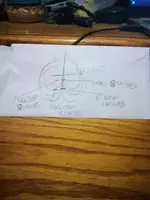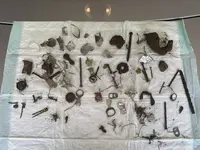The Nox does have good target separation, but because of it's priority defaults (size & shape) and its very narrow VDI scale, it isn't all that good (capable) at classifying potential gold and silver jewelry items because when it comes to gold and silver jewelry there there are no consistencies in the various sizes and shapes of these items, unlike coins, where each denomination is pretty darn consistent.
As for the sensitivity issue, just lay a quarter on a clean section of ground and see how the target signature gets smaller and larger as you decrease and increase the sensitivity, this only becoming even more exaggerated the closer the item gets to the coil.
Now, with that same quarter and clean ground, start with a high sensitivity setting and see how high you can raise the coil before you start losing the return, this space (depth) will continue to decrease as you continue lowering the sensitivity. But you're not making the field smaller, you're just filter out more noise which includes those weaker target returns. Increase the sensitivity and you'll start getting those deeper (weaker) returns on the quarter again.
As for a video, I'll have to think on that because it would be a rather complicated and long topic. Maybe I could do a series on hunting super trashy areas and address each issue in its own video? Interesting idea that I'll have to ponder over.....
I can agree with many (most) of your points and descriptions of how targets respond when varying sensitivity etc., but as an engineer familiar with signal processing, I have to disagree with your characterization of sensitivity as a filter and also your argument that the compressed VDI scale of the Equinox as somehow limiting the classification of jewelry or even coins and your previous statements that the limited VDI scale somehow indicates an inferior discrimination implementation or is simply inferior to 100-segment ID implementations.
The former comes down simply to terminology I believe, because your description of how sensitivity affects target signal return strength is accurate. But sensitivity is not a filter so much as a gain level adjustment. The problem is that detector manufacturers are inconsistent in their use of terminology of such features such as sensitivity, gain, and transmit power which are improperly used interchangeably and which results in confusion. Sensitivity as implemented in the Nox simply limits the amplitude (amplification) of of the raw target signal (which is received and sampled at the various operating frequencies) before it is digitized and applied to the digital signal processor. A filter would limit the bandwidth (range of target frequencies) that are let into the signal processor - such a filter could be used to limit noise or to notch out specific types of signals.
Regarding the "compressed" range of the Equinox VDI, I have a different take because it appears to be an intentional design decision by Minelab to provide improved target ID stability and repeatability. Yes, there is less precision vs. a 100 segment scale, but I have found the precision of a 100 segment is somewhat worthless if the VDI is constantly bouncing around which is typical of most 100-segment detectors such as Fishers, Deus, and Nokta. Minelab made the conscious decision to prioritize stable and repeatable target IDs which can be used to advantage in detecting - for example, it is really an asset to have a clean nickel repeatedly ID at 13 rather than bounce around between 52 and 55, which is what I often see on my Deus. On my Deus pull tabls also bounce around in this region. On my Nox, pull tabs are either notoriously unstable (a giveaway) or stable but rarely if ever fall on a TID of 13. So in this case, the 50-segment Nox provides the superior TID implementation to help me sort through non-ferrous trash vs. a very capable 100-TID detector. Now if ML can retain the repeatability and stability of the Equinox TID and also increase precision (and perhaps add target information as they do with the FBS2 units with FE-CO target ID numbers) then that would be a great update and replacement for the aging CTX 3030 and eTrac FBS2 detector platforms. A Multi-IQ based detecting with the discrimination sophistication and target ID information implemented in the CTX but with the Speed and adjustability of the Nox would be a formidable high end unit. I am pretty sure Minelab is working on that and I am looking forward to it. Your statement that you can't classify silver and gold jewelry as a result of the fact that "there are no consistencies in the various sizes and shapes of these items" means that a 100 segment ID machine would also have no additional success in classifying these targets. In fact, due to the target ID variablity that results from these targets, I would argue that with a less stable 100-segment ID output, you would be hard-pressed to make any kind of consistent call. The gold items I have found with the Nox pretty much display a solid, stable ID (yes, that ID varies from target to target based on shape, mass, and whether you have a closed loop) vs. modern trash that rings up and bounces around in that range. Regarding silver jewelry, it will usuall ring up high regardless and I am not leaving any repeatable high tone in the ground regardless of target ID. Whether its a 21, 27, or 32, if it is repeatable, I'm just digging it and finding out what it is once I have it out of the ground
I completely agree with many of the points you have made above regarding the magnetic field characteristics of different coils and how sensitivity does not affect field strength, how too much sensitivity can actually reduce your ability to discern a target, etc. How lowering sensitivity can actually enhance you ability to pick up shallower keepers between trash targets (to the OPs original question). You are spot on.
You may disagree with the above, and frankly, that's your right, I am not going to engage in a prolonged debate about it like you are having with Sube on the other issues, because it is not really that big a deal - just disagree on calling sensitivity a filter and disagree that the limited VDI range on Equinox is a liablity- that's all. Otherwise, there is a lot of common ground so I don't want to take away from that with a debate. I just couldn't hold back any longer as you continued to call sensitivity a filter. I'm OCD, I guess.









